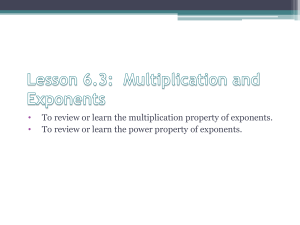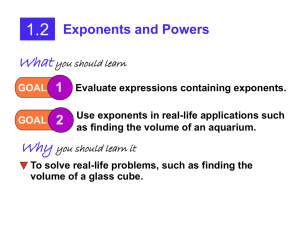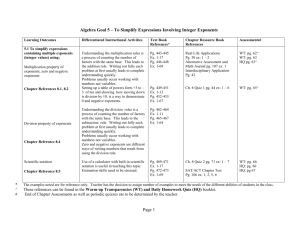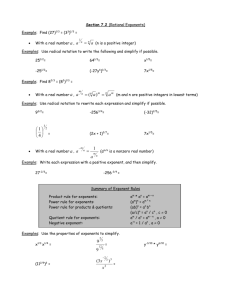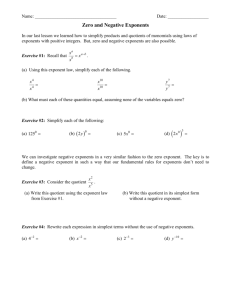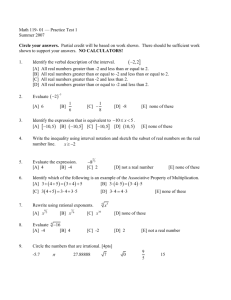Zero and Negative Exponents - grade8commoncoremath
advertisement
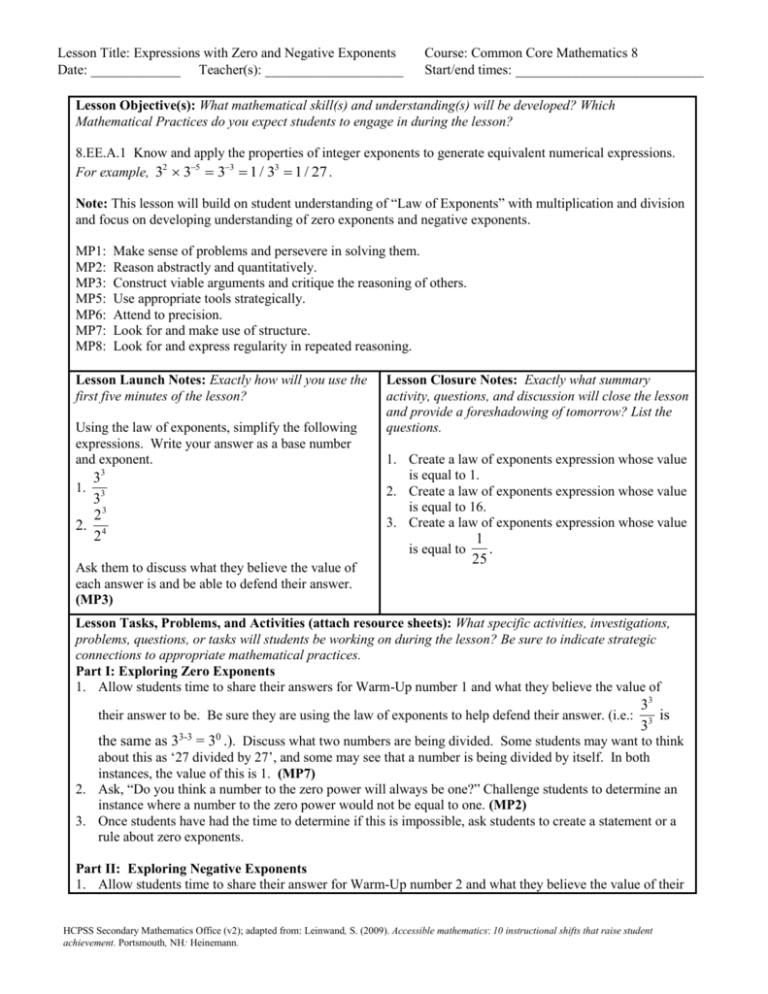
Lesson Title: Expressions with Zero and Negative Exponents Date: _____________ Teacher(s): ____________________ Course: Common Core Mathematics 8 Start/end times: _________________________ Lesson Objective(s): What mathematical skill(s) and understanding(s) will be developed? Which Mathematical Practices do you expect students to engage in during the lesson? 8.EE.A.1 Know and apply the properties of integer exponents to generate equivalent numerical expressions. For example, 32 35 33 1 / 33 1 / 27 . Note: This lesson will build on student understanding of “Law of Exponents” with multiplication and division and focus on developing understanding of zero exponents and negative exponents. MP1: MP2: MP3: MP5: MP6: MP7: MP8: Make sense of problems and persevere in solving them. Reason abstractly and quantitatively. Construct viable arguments and critique the reasoning of others. Use appropriate tools strategically. Attend to precision. Look for and make use of structure. Look for and express regularity in repeated reasoning. Lesson Launch Notes: Exactly how will you use the first five minutes of the lesson? Using the law of exponents, simplify the following expressions. Write your answer as a base number and exponent. 3 3 33 23 2. 4 2 1. Ask them to discuss what they believe the value of each answer is and be able to defend their answer. (MP3) Lesson Closure Notes: Exactly what summary activity, questions, and discussion will close the lesson and provide a foreshadowing of tomorrow? List the questions. 1. Create a law of exponents expression whose value is equal to 1. 2. Create a law of exponents expression whose value is equal to 16. 3. Create a law of exponents expression whose value is equal to 1 . 25 Lesson Tasks, Problems, and Activities (attach resource sheets): What specific activities, investigations, problems, questions, or tasks will students be working on during the lesson? Be sure to indicate strategic connections to appropriate mathematical practices. Part I: Exploring Zero Exponents 1. Allow students time to share their answers for Warm-Up number 1 and what they believe the value of their answer to be. Be sure they are using the law of exponents to help defend their answer. (i.e.: 33 is 33 the same as 33-3 = 30 .). Discuss what two numbers are being divided. Some students may want to think about this as ‘27 divided by 27’, and some may see that a number is being divided by itself. In both instances, the value of this is 1. (MP7) to determine an 2. Ask, “Do you think a number to the zero power will always be one?” Challenge students instance where a number to the zero power would not be equal to one. (MP2) 3. Once students have had the time to determine if this is impossible, ask students to create a statement or a rule about zero exponents. Part II: Exploring Negative Exponents 1. Allow students time to share their answer for Warm-Up number 2 and what they believe the value of their HCPSS Secondary Mathematics Office (v2); adapted from: Leinwand, S. (2009). Accessible mathematics: 10 instructional shifts that raise student achievement. Portsmouth, NH: Heinemann. Lesson Title: Expressions with Zero and Negative Exponents Date: _____________ Teacher(s): ____________________ Course: Common Core Mathematics 8 Start/end times: _________________________ 23 answer to be. Be sure they are using law of exponents to help defend their answer. (ie: 4 is the same as 2 2. 3. 4. 5. 6. 7. 8. 9. 23-4 = 2-1). Some students may argue that the number will be negative. Ask them to defend their answer. Discuss what numbers are being divided to help students determine that the value will be a decimal. Do not give the actual value of 2-1. Students will spend time exploring negative exponents and determining the pattern. (MP6) Give each student a copy of the Exploring Negative Exponents. Allow students time to complete the first table only. Instruct students to complete the entire second column using the law of exponents and complete the values they know from the third column. (Students should be able to complete the bottom 4 rows using their knowledge of positive exponents and zero exponents.) Watch for mistakes on the last column. Remind students they are subtracting -1 from 2. (2 – (-1)). Allow students to think-pair-share on any pattern that seems to exist in the third column. Ask, “What do you notice about the last 4 rows in the table? What appears to be happening to the values as you look up/down the last column of the table?” (MP8) Allow students time to make predictions on the possible values that should be placed in the last column. Distribute scientific or graphing calculators (that have a function for negative exponents) to solve or do a class demonstration. (MP5) Show students or have students determine the missing values. Discuss the possible reasons for the values and look for patterns. Do not explain how negative exponent values are determined. Have students complete the second chart (without a calculator) and fill in all the values they know. Let them discuss answers in groups and then out loud. Focus the discussion on how they are determining their negative exponents (if they have) or what pattern exists in the bottom 5 rows of their table. (MP1) Allow students to calculate the values for the numbers raised to negative exponents and Think-Pair-Share on the patterns that seem to exist. Ask, “How did the pattern change from the first table to the second table? How is it the same? How do you think you determine the value of a number raised to a negative exponent?” (MP8) Once students have determined how numbers raised to negative exponents are calculated, ask students to create a statement on how to find the value of any number that is raised to a negative exponent. Provide students with 2-3 additional practice problems where they need to determine the value of a number raised to a negative exponent. Be sure to take time to discuss the process and the pattern that exists. Ask students to look back to the statement they created in step 7 to be sure it is clear. Exit Ticket: See Lesson Closure Notes. Evidence of Success: What exactly do I expect students to be able to do by the end of the lesson, and how will I measure student mastery? That is, deliberate consideration of what performances will convince you (and any outside observer) that your students have developed a deepened (and conceptual) understanding. Students understand how an exponent of zero results in a value of 1. Students will calculate the value of numbers when they are raised to a negative exponent. Notes and Nuances: Vocabulary, connections, common mistakes, typical misconceptions, etc. Vocabulary: exponent, base number, law of exponents Connections: Use this lesson following the 8.EE.1 Part 1 lesson where students are learning the law of exponents with multiplication and division. Common mistakes: Students may multiply the base number and the exponent when calculating values rather than using repeated multiplication. HCPSS Secondary Mathematics Office (v2); adapted from: Leinwand, S. (2009). Accessible mathematics: 10 instructional shifts that raise student achievement. Portsmouth, NH: Heinemann. Lesson Title: Expressions with Zero and Negative Exponents Course: Common Core Mathematics 8 Date: _____________ Teacher(s): ____________________ Start/end times: _________________________ Resources: What materials or resources are Homework: Exactly what follow-up homework tasks, essential for students to successfully complete the problems, and/or exercises will be assigned upon the lesson tasks or activities? completion of the lesson? Exploring Negative Exponents Distribute problems that allow them to practice finding the values of numbers raised to negative exponents. This could be done in a matching, multiple choice, or fill in the blank format. Also consider providing questions similar to the questions on the exit ticket. Lesson Reflections: How do you know that you were effective? What questions, connected to the lesson standards/objectives and evidence of success, will you use to reflect on the effectiveness of this lesson? Are students able to find the value of numbers raised to the zero power and explain the reasoning? Are students able to find the value of numbers raised to a negative exponent and explain the reasoning behind their answer? Howard County Public Schools Office of Secondary Mathematics Curricular Projects has licensed this product under a Creative Commons Attribution-NonCommercial-NoDerivs 3.0 Unported License. HCPSS Secondary Mathematics Office (v2); adapted from: Leinwand, S. (2009). Accessible mathematics: 10 instructional shifts that raise student achievement. Portsmouth, NH: Heinemann.




